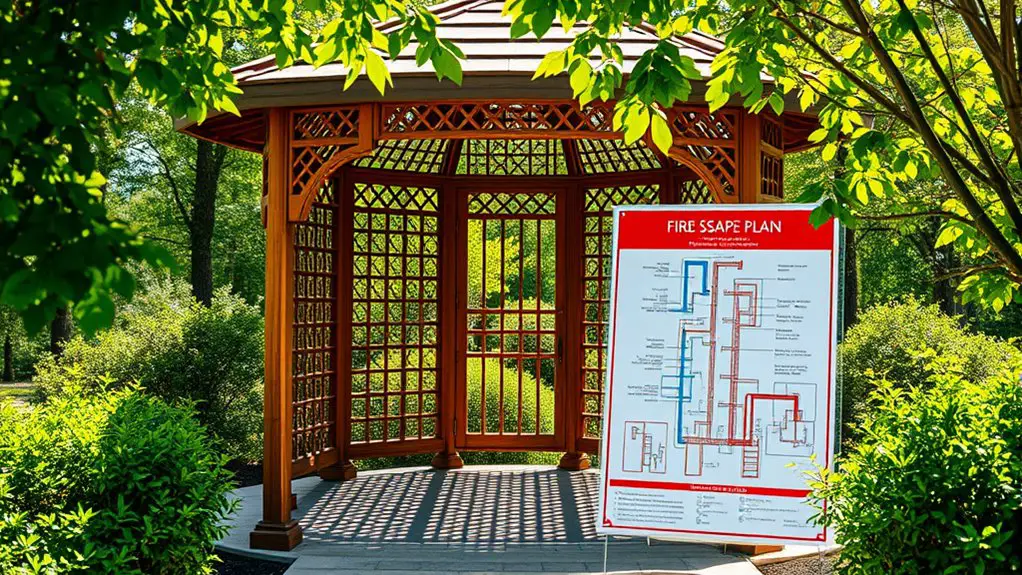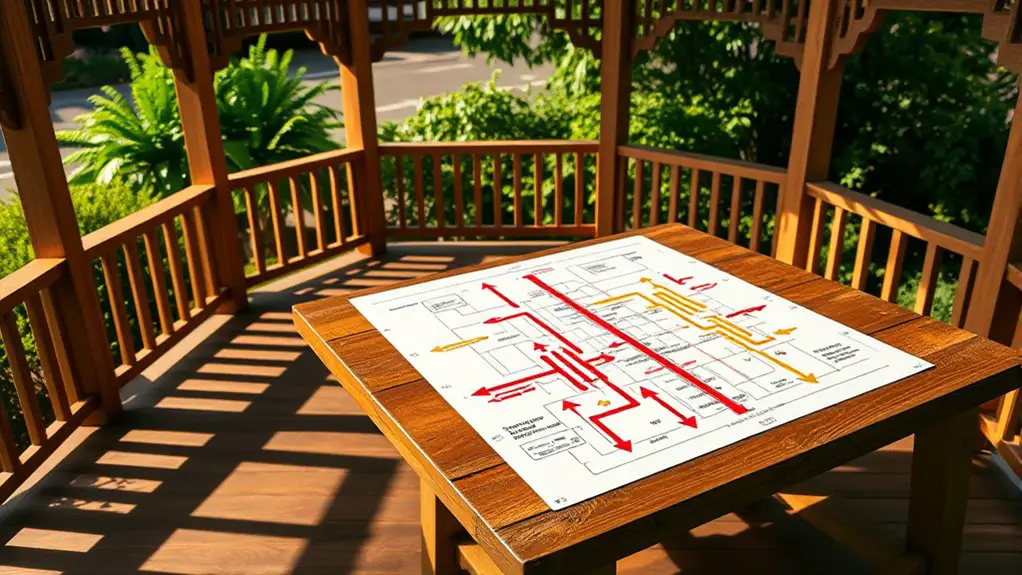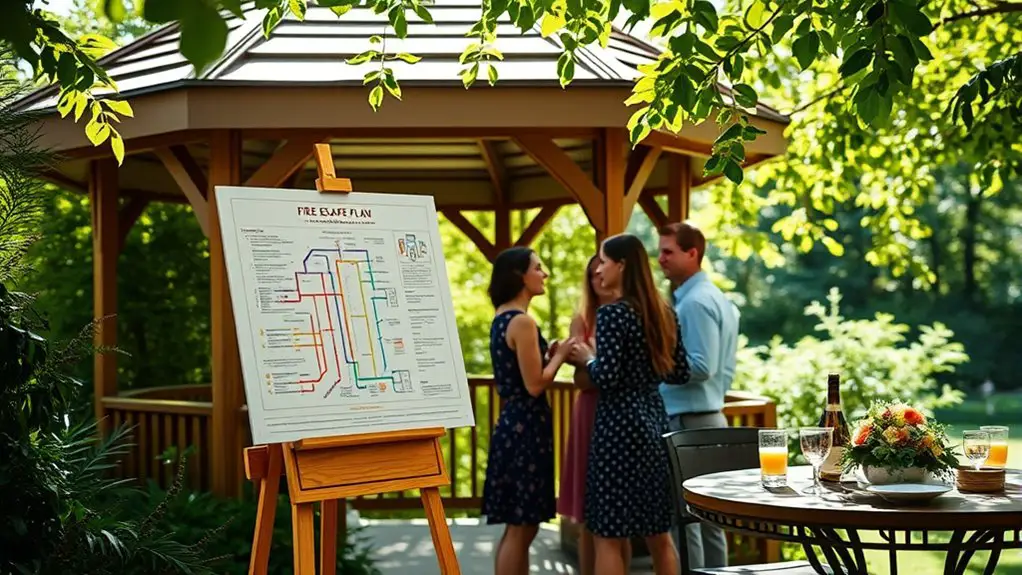When planning fire escape routes for enclosed gazebos, it’s essential to assess the design and layout carefully. Make certain exits are clearly marked and easily accessible. Communicate the escape plan to your guests upon arrival, using visual aids for clarity. Equip your gazebo with important safety gear, like fire extinguishers and first aid kits. Regularly review and practice your emergency plan to guarantee everyone knows what to do. Understanding these factors is critical for enhancing safety during gatherings.
Understanding the Risks of Enclosed Gazebos

Although enclosed gazebos can provide a cozy retreat, they also come with significant risks that shouldn’t be overlooked. One critical concern is fire hazards; these structures, often constructed from wood and fabric, can easily ignite. If you decide to use heating elements or open flames, the risk escalates dramatically.
Moreover, the enclosed nature of these gazebos may compromise smoke ventilation. In the event of a fire, smoke can accumulate rapidly, creating a dangerous environment. Without proper ventilation systems, toxic fumes can become trapped, posing serious health risks to you and your guests.
To enjoy the freedom of your gazebo while minimizing danger, it’s vital to assess these risks carefully. Regularly inspect for flammable materials, and consider implementing smoke ventilation strategies. Prioritizing safety guarantees that your cozy haven remains a place of relaxation, not a potential hazard. Additionally, ensure compliance with local regulations to prevent legal issues and enhance safety measures.
Importance of Fire Safety in Outdoor Spaces
Fire safety in outdoor spaces is often underestimated, yet it plays an essential role in ensuring enjoyable and worry-free gatherings. When you’re hosting an event, it’s vital to implement effective fire prevention strategies to protect yourself and your guests. This means considering the materials used in your gazebo and any enclosures, as well as being mindful of nearby flammable items.
Outdoor safety measures, such as having a designated fire extinguisher and ensuring proper ventilation, can make all the difference. Regularly inspect your setup for potential hazards and establish clear escape routes. Educate your guests on emergency procedures, so everyone knows what to do in case of a fire.
Assessing Your Gazebo’s Design and Layout

When evaluating your gazebo’s design and layout, consider the materials used for enclosure, as they can greatly impact fire safety. Evaluate the entrance and exit routes to guarantee they’re easily accessible and unobstructed in case of an emergency. A well-thought-out design can enhance both the aesthetic and safety of your outdoor space.
Gazebo Enclosure Materials
Choosing the right materials for your gazebo enclosure is essential, as it not only affects the overall aesthetic but also impacts safety and functionality. Wood materials provide a classic, natural look but require maintenance. Vinyl options offer durability and are low-maintenance, making them an attractive choice. For airflow and pest control, screen enclosures are practical, allowing you to enjoy the outdoors without unwanted visitors. If you’re after a sleek appearance, consider metal frames that provide strength and stability. Fabric curtains can enhance privacy and add color, though they may not be as fire-resistant. Finally, glass panels create an upscale feel while maintaining visibility. Weighing these materials will help you achieve an ideal balance between design and safety.
Entrance and Exit Routes
Ensuring clear entrance and exit routes in your gazebo design is essential for safety, especially in emergency situations. You should assess entrance visibility to guarantee it’s unobstructed and easily recognizable from various angles. Consider positioning your exits strategically, ensuring they’re accessible without obstacles that could hinder a quick departure.
When planning your gazebo layout, think about the flow of movement; a well-structured design promotes efficient exit accessibility. Use signage or contrasting colors to enhance visibility of entrances and exits, making them intuitive for all users. Regularly evaluate these routes to adapt to any changes in your gazebo, ensuring they remain functional and clear. Prioritizing these elements will empower you and your guests to enjoy your space with peace of mind.
Identifying Escape Routes and Exits
To effectively identify escape routes and exits for a gazebo, you’ll need to assess the layout and surroundings carefully. Start by mapping out all possible exits, guaranteeing they’re clear of obstacles. Consider the placement of escape route signage to guide individuals swiftly during an emergency. Each route should be easily accessible and lead to a safe area away from the gazebo.
Next, install emergency lighting along these routes to enhance visibility in low-light situations. This will guarantee that, even in panic, everyone can quickly locate exits. Pay attention to the positioning of furniture or decor that might obstruct pathways; keep these areas open and well-marked.
Finally, regularly review and update your escape routes based on any changes to the gazebo or its environment. This proactive approach will empower you and your guests, providing a sense of security and freedom in knowing that a clear path to safety exists.
Communicating the Escape Plan to Guests

Once you’ve identified clear escape routes and exits, the next step is effectively communicating this plan to your guests. Start with guest briefings upon arrival, guaranteeing everyone understands the escape routes and exits. Use concise and straightforward language to avoid confusion. Visual aids, like maps or diagrams, can enhance understanding; place them prominently in the gazebo for easy reference.
Consider conducting short sessions where you walk guests through the plan, emphasizing key points like the nearest exits and assembly areas. Encourage questions to clarify any uncertainties. It’s essential that your guests feel empowered and informed, fostering a sense of freedom in knowing they can act confidently in an emergency.
Revisit this information regularly, especially if new guests arrive, to maintain awareness. By creating an open dialogue about the escape plan, you guarantee everyone is prepared, which ultimately enhances safety and peace of mind.
Conducting Fire Drills for Preparedness
Conducting regular fire drills is essential for ensuring everyone knows the escape plan and can act quickly in an emergency. You’ll want to assign specific roles to participants during these drills, so everyone understands their responsibilities. This preparation not only reduces panic but also enhances overall safety in the event of a fire.
Importance of Regular Drills
While it may seem unnecessary at times, regularly conducting fire drills for your gazebo is essential for ensuring everyone knows how to respond effectively in an emergency. Consistent drill frequency helps reinforce safety protocols, making them second nature. It’s vital to engage participants actively during these drills; when they’re involved, retention of information increases markedly. Encourage questions and discussions to enhance understanding and confidence. By simulating various scenarios, you prepare everyone for real-life situations, reducing panic and confusion. Remember, each drill should be an opportunity to assess and improve your escape plan, identifying potential obstacles and refining your procedures. Ultimately, these drills empower everyone, fostering a sense of community and ensuring freedom through preparedness.
Roles During Fire Drills
Understanding the specific roles during fire drills is essential for effective preparedness, as each participant contributes to the overall safety of the group. Assign fire drill roles clearly—designate a leader to coordinate the exercise, ensuring everyone knows the escape routes. A communicator should relay information and updates, while another team member monitors the time, ensuring drills are timely.
It’s crucial for participants to familiarize themselves with their team responsibilities, such as assisting those with mobility challenges. Encourage everyone to practice their roles regularly so they feel confident in an emergency. This clarity empowers individuals, fostering a sense of freedom to act decisively should a real fire occur, enhancing the collective security of your gazebo environment.
Equipping Your Gazebo With Safety Gear
To guarantee your gazebo is prepared for emergencies, it’s essential to equip it with the right safety gear. Proper safety equipment can make a significant difference during critical situations. Here’s a concise list of must-have emergency supplies for your gazebo:
- Fire Extinguisher: Verify it’s easily accessible and rated for all types of fires you might encounter.
- First Aid Kit: Stock it with essential items like bandages, antiseptic wipes, and burn cream to address injuries promptly.
- Flashlight and Batteries: Keep a reliable flashlight handy in case of power outages, along with extra batteries for extended use.
Establishing a Meeting Point After Evacuation
Establishing a clear meeting point after evacuation is essential for ensuring everyone’s safety and accountability during an emergency. Choose a designated meeting location away from the gazebo, ideally a landmark, such as a large tree or a specific bench, that’s easily recognizable. This helps prevent confusion and allows for swift gathering.
Communicate this meeting location to all your guests before an emergency occurs. Make sure everyone understands its importance for guest accountability. Designate a responsible individual to take note of who’s present and who may be missing, allowing for quick action if someone is unaccounted for.
Regularly remind guests of the meeting point during gatherings, reinforcing its significance. This approach not only enhances safety but also fosters a collective sense of responsibility. By establishing this structure, you empower everyone to act decisively and confidently, ensuring that safety remains a shared priority in any emergency situation.
Regularly Reviewing and Updating Your Plan
Once everyone has gathered at the designated meeting point, it’s important to ascertain that your fire escape plan remains effective over time. Regular reviews and updates ascertain that your plan evolves alongside any changes in your environment, occupants, or safety regulations. Here are three key areas to focus on during your plan revisions:
- Emergency Contacts: Verify that all emergency contact information is current. Ascertain everyone knows who to reach out to in case of an emergency.
- Escape Routes: Reassess your escape routes regularly. Make sure they’re clear of obstructions and easily accessible for all individuals using the gazebo.
- Training: Conduct regular drills to reinforce the plan. This keeps everyone familiar with the procedures and boosts their confidence in emergencies.
Frequently Asked Questions
What Materials Are Best for Fire-Resistant Gazebo Enclosures?
When considering fire resistant materials for enclosure designs, focus on non-combustible options like steel, fiberglass, or tempered glass. These can enhance safety while allowing flexibility in creating a stylish, functional outdoor space that guarantees your freedom.
How Often Should I Check My Fire Safety Equipment?
You should check your fire safety equipment monthly. Verify smoke detector testing is done regularly, and don’t forget fire extinguisher maintenance; it’s essential to guarantee your safety and maintain your freedom in emergency situations.
Can I Install a Fire Alarm in My Gazebo?
Did you know that 60% of home fire fatalities occur in homes without alarms? You can install various fire alarm types in your gazebo, ensuring safety during gatherings. Prioritize proper gazebo installations for maximum protection.
What Should I Include in My First Aid Kit for Fire Emergencies?
You should include various fire extinguisher types, gloves, a flashlight, and emergency contact numbers in your first aid kit. This guarantees you’re prepared for any fire emergency, promoting safety and freedom in your environment.
Are There Fire Regulations for Outdoor Gatherings in My Area?
You should check your local fire codes for outdoor gatherings. Understanding these regulations guarantees you’re compliant and prioritizing outdoor fire safety. Knowing the rules can help you enjoy your freedom while keeping everyone safe.

